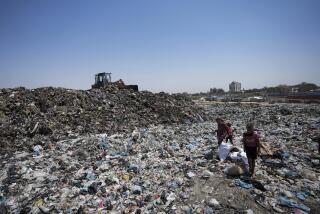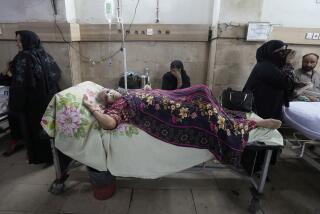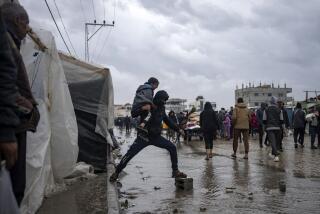Finding Adequate Shelter Vital for Quake Survivors
MUZAFFARABAD, Pakistan — As rain pelted a muddy soccer field Saturday, Zulfiqar Butt wrestled with a 4-foot length of broken window frame and a wind-whipped tarpaulin, eventually planting the wood scrap in the sodden earth to serve as a tent pole.
As soon as the lean-to was erected, 12-year-old Noman Shahid ducked inside and turned sad brown eyes, a runny nose and chattering teeth in silent appeal to Butt, lord of the newest manor. Perhaps the stranger would offer refuge to his family.
“We have no place to sleep except in the open,” Noman said, shivering in the thin blue shirt of a school uniform that is his only clothing. The boy explained that his father and a brother died in the Oct. 8 earthquake, his mother was injured, and he and his three surviving siblings were too young to compete with the desperate men fighting for the occasional tent tossed from the back of an aid truck.
A week after the devastating magnitude 7.6 temblor that killed at least 38,000 people, tents are all that stand between dying of exposure or surviving for another week, never mind the looming Himalayan winter.
With proper tents in shockingly short supply in Muzaffarabad, a frantic building boom has beset this pulverized city, with the displaced scavenging corrugated metal sheets from the ubiquitous rubble to put roofs over their heads. Bedclothes, curtains and carpets hang from the crumpled metal, rippling in the wind but keeping most of the rain out.
In one pieced-together shelter, Abdul Rashid lamented the chaos and confusion that afflict the delivery of supplies. Aid workers fearful of being mobbed have taken to hurling their offerings from the back of moving flatbeds and pickups, sometimes lobbing the goods over the walls of the soccer field, inciting a panicked scramble.
“When the food trucks come, everyone runs and grabs. The strong are the only ones who get something to eat,” said the distraught father, who lost five of his 14 family members when their home collapsed in the earthquake.
With all aid deliveries from the capital, Islamabad, forced to use the sole road to this Kashmir regional capital, many people have pitched their shelters along the narrow, fissured route to be close to the lifeline.
Rubina Afzal peered out from beneath a white tarpaulin attached to a metal bus shelter awning and surrounded with a 3-foot-high fence of woven rattan. She had been there with her husband, brother-in-law and six children since they made the three-day trek down from their destroyed village, more than 30 miles away.
“It’s a good place to be. Everything here we got from the aid trucks. Nothing was left of our home, and we couldn’t carry much on the walk here because of the children,” she said, gesturing at the clutch of juice-sipping young ones watching the cacophonous bustle of teetering buses, overloaded trucks, relief convoys and police cars with sirens wailing.
Rebuilding the quake-ravaged area will take years and cost at least $5 billion, Prime Minister Shaukat Aziz said Saturday. He repeated the relief effort’s refrain: Pakistan needs tens of thousands of tents to house its homeless, estimates of whom reach 2.5 million.
Once the rain let up around midday, a makeshift airstrip and relief depot suddenly hummed with action. Half a dozen helicopters buzzed through the sky like dragonflies, ferrying tents, food and medicine from Islamabad and moving the injured from mountain villages to a field hospital now functioning at the airstrip. A military helicopter returning from a relief mission crashed late Saturday in bad weather near the town of Bagh, officials said early today, killing six soldiers.
Rashida Begun had been sitting on the fringes of the airstrip here for five days, waiting for room on a helicopter to allow her to return with her elderly aunt and 4-year-old son, Abdullah, to their mountain village more than 10 miles away. They were rescued Tuesday and brought to the airstrip field hospital to set Abdullah’s broken leg and the aunt’s fractured elbow, treatment dispensed within hours of their arrival.
“My kids are alone,” Begun said of the three left behind -- and of 10-year-old Arslan, who died in their home’s cave-in.
Mohammed Afzal’s quest to get home with his injured wife was even more pressing. Four of his eight children died in the earthquake, and among the survivors was a nursing infant bereft of his mother’s milk for four days.
“I just want one tent and to take my wife back to our baby,” pleaded the electrician, a tear escaping along a wrinkle on his weathered face. “It’s freezing up there and the rest of our children will die if they have no cover.”
In a tent at the field hospital, Karachi businessman-turned-volunteer Adnan Asdar checked on the progress of a surgery needed to deliver a baby from a woman with a crushed pelvis.
“These are procedures after which you’d expect patients to spend several days in the hospital under observation. But we just don’t have that luxury,” said the harried volunteer with the Karachi-based Citizens Foundation, which has mobilized surgeons, contractors and engineers.
In addition to space for post-op recovery, he said, the mission needs thousands of tents to house the legions of homeless before they die of exposure, pneumonia or infectious diseases.
Asdar warned that even the increased fatality figure of 38,000 the army reported Saturday is woefully short of the real toll.
“See all those slide areas,” Asdar said, pointing to ocher blotches of sheared-off hillsides that dapple the towering mountains surrounding the Jhelum valley. “Those used to be entire villages, and we’ve heard nothing from them. We have to presume that everybody was killed when the landslides hit them.”
His educated guess on the number killed: 75,000. The Pakistani army general in charge of strategic health issues, Brig. Khalid Hussein, agreed. “The death toll will be much, much higher,” he said.
Those isolated in desolate mountain hamlets without phones, power or roads even before the earthquake have been descending by the thousands each day, plying the goat tracks that lead to the riverfront roadway to collect food, water and whatever else the steady stream of relief trucks has to offer.
Some of the relief goods proved disappointing. When a truck from Rawalpindi parked at the confluence of a highland trail and the battered riverside roadway, an eager line of the homeless and hungry besieged it. Zahir Abbasi began throwing out heaps of textiles -- summer dresses, light sweaters, empty grain sacks, a satin table runner.
“We will try to make some use of this,” said Safbar Hussein, who had walked 40 miles in search of a means of survival for his eight children left in the open. “All the help is appreciated, but what we need is shelter. We need tents. We need to get inside at night before we get pneumonia.”
More to Read
Sign up for Essential California
The most important California stories and recommendations in your inbox every morning.
You may occasionally receive promotional content from the Los Angeles Times.











